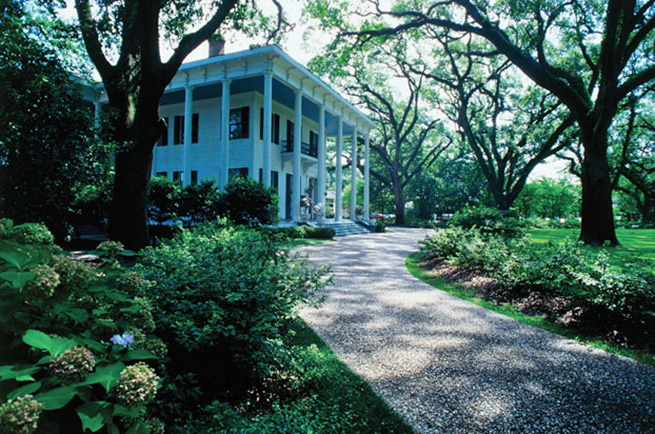
Bragg-Mitchell House, Mobile; credit Mobile CVB
Mobile Historic Sites
Slave Market Site
DESCRIPTION: Since the cities founding a century slave-holders met to trade slaves for commerce on this site. Though federal legislation officially ended the importation of slaves in 1808, there were flagrant violations of the law until 1860. Slave trade remained very active in Mobile for decades longer.
ADDRESS: St. Louis Street at Royal Street, Mobile, AL MAP
Mobile Public Library, Davis Avenue Branch
DESCRIPTION: Built in 1931 to serve the needs of the African American community the Davis Avenue branch library is a small-scale version of the local public library. It reflects a social climate where African Americans were provided with separate educational facilities.
ADDRESS: 564 Davis Avenue, Mobile, AL MAP
Bragg-Mitchell Mansion
DESCRIPTION: Built in 1855, the Bragg family split their time between this Mansion and their cotton plantation in Lowndes County outside of Montgomery. Judge Bragg died in 1878, and four additional families have owned the home since his passing. The last private owner was the A.S. Mitchell family who purchased the home and property in 1931 and occupied it until 1965 — during that time, the Mansion became an icon of the city. This restored twenty-room mansion is adorned with period furnishings, artwork, double parlors, a lavish dining room, stenciled moldings and grounds with Mobile’s trademark live oaks and azaleas. Given its contruction period and location, a number of Black craftsmen were involved in building this National Historic Landmark.
ADMISSION: $5 Adults, $3 students and children
DAYS & HOURS: Tue–Fri 10a-4p
ADDRESS: 1906 Springhill Avenue, Mobile, AL MAP
PHONE: 251-471-6364
WEBSITE: http://www.braggmitchellmansion.com
Hawthorne House
DESCRIPTION: Built in 1853, the house — a rather simply detailed Gulf Coast Cottage — was occupied by the Reverend Joshua Kedar Hawthorne, a White minister who moved to Mobile from Conecuh County where he reputedly worked with free Black churches.
ADDRESS: 352 Stanton Road, Mobile, AL MAP
Hunter House
DESCRIPTION: This two-story Italianate home matches in scale, character and architectural detail White owned Mobile residences of the period. It is also significant for its association with Bettie Hunter, an affluent 19th-century Black business woman.
ADDRESS: 503 St. Francis Street, Mobile, AL MAP
Historic Blakely Park
DESCRIPTION: 9 Black Regiments of General Hawkins helped capture Fort Blakely on 9 April 1865. This action quickly led to the Confederates to cede Mobile to Union Forces and help draw the Civil War to an end. Many Black soldiers who died in the Civil War are buried in Magnolia Cemetery.
ADDRESS: 33707 Alabama Highway 225, Mobile, AL MAP
Mount Vernon Arsenal-Searcy Hospital Complex
DESCRIPTION: Called Fort Stoddert in 1799, it was renamed Mt. Vernon Arsenal in 1828. During the Civil War it was seized by Confederate troops, but was returned to the federal government after the war. Later the state legislature established Mt. Vernon Hospital to relieve overcrowding at Bryce Hospital, the state psychiatric facility. Mt. Vernon was designated exclusively for the care of the African-American mentally ill, until it was desegregated in 1969.
ADDRESS: Coy Smith Highway, Mobile, AL MAP
Africatown
DESCRIPTION: The heritage of a people brought from the Gulf of Guinea in West Africa to Mobile on a slave ship still lives on in Africatown. This area, about 3 miles north of Mobile, received its name because of its African population and culture. On the night of July 9, 1860, the slave ship Clotilde, headed by Captain William Foster, entered Mobile Harbor. Due to the outlaw of African slave trade since 1808, Captain Foster had to transfer the slaves from the ship into a riverboat to bring them into Mobile. He then burned and sunk the Clotilde. Once sold to those interested in the Clotilde expedition, these enslaved Africans–intelligent, hard-working and industrious people — created their own neighborhood at Magazine Point, a community that still lives on today. In fact, many descendants of Cudjoe Kazoola Lewis, the last survivor of the Clotilde, still reside here and a bust of him sits in front.
ADDRESS: Union Missionary Baptist Church, Plateau, AL MAP
PHONE: 251-433-8511
Whistler
DESCRIPTION: Alabama’s largest historically Black town with a number of historic sites
ADDRESS: Area surrounding Whistler Street and Wasson Avenue, Whistler, AL MAP

Thank you for the very informative list. I’m from Mobile and I’m sad to say that I have not been to several of these places. The next time I head back, I plan on taking your list with me and exploring the side to the city that many, particularly white people, don’t want to talk about.